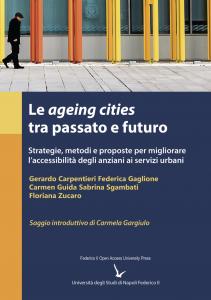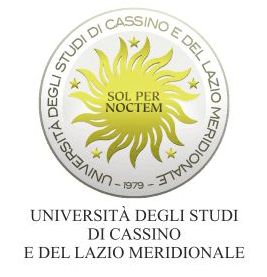Le ageing cities tra passato e futuro. Strategie, metodi e proposte per migliorare l’accessibilità degli anziani ai servizi urbani
Keywords:
Accessibility, Urban planning, Ageing cities, Urban servicesSinossi
Editore: FedOA Press - Federico II Open Access University Press
Collana: Smart City, Urban Planning for a Sustainable Future
Pagine: 187
Lingua: Italiano
NBN: http://nbn.depositolegale.it/resolver.pl?nbn=urn:nbn:it:unina-27508
Abstract: Il volume raccoglie le conclusioni di un lavoro di ricerca che costituisce il naturale quanto autonomo sviluppo dei risultati del progetto MOBILAGE – Mobility and ageing: daily life and welfare supportive networks at the neighborhood level, finanziato nel biennio 2018-2020 da Fondazione Cariplo (Gant N° 2017-0942) e concluso nel giugno 2020.
La questione ageing cities negli ultimi tempi ha assunto la connotazione di vera e propria emergenza soprattutto in ragione dei trend di crescita della popolazione anziana nelle città industrializzate. Il tema, di estrema rilevanza sia nel dibattito scientifico che nella prassi operativa nazionale e internazionale, si configura come una delle sfide/opportunità per ripensare/ridisegnare le città migliorando la qualità di vita degli anziani.
Il gruppo di ricerca impegnato in questo lavoro, sotto la guida di Carmela Gargiulo, è costituito da giovani ricercatori che afferiscono al laboratorio TeMALab del Dipartimento di Ingegneria Civile, Edile e Ambientale (DICEA) dell’Università di Napoli Federico II.
Downloads
Riferimenti bibliografici
Ahn, J.S., Kim, L.B. & Park M.R. (2014). An analysis of variation of spatial accessibility pattern based on 2SFCA: A case study of welfare facilities for the aged in Gumi city. Journal of the Korean Association of Geographic Information Studies, 17 (4) (2014), pp. 112-128, 10.1016/j.trpro.2016.11.080
Alidoust, S., Holden, G., & Bosman, C. (2014). Urban environment and social health of the elderly: A critical discussion on physical, social and policy environments. Athens journal of health, 1(3), 169-80. https://doi.org/10.30958/ajh.1-3-1
Alley, D., Liebig, P., Pynoos, J., Banerjee, T., & Choi, I. H. (2007). Creating elder-friendly communities: Preparation for an aging society. Journal of Gerontological Social Work, 49, 1–18.
Arup (2019) Cities Alive: Designing for ageing communities. Disponibile al link: https://www.arup.com/perspectives/publications/research/section/cities-alive-designing-for-ageing-communities
Arup, Help Age International, Intel, Systematica, (2015). Shaping Ageing Cities: 10 European case studies. Disponibile al link: https://ifa.ngo/publication/demographics/shaping-ageing-cities-10-european-case-studies/
Banister, D. (2019). Transport for all. Transport Reviews, 39:3, 289-292. https://doi.org/10.1080/01441647.2019.1582905
Banister, D., Givoni, M., Macmillen, J., & Schwanen, T. (2013). 16. Thinking change and changing thinking. Moving towards low carbon mobility, 267.
Battarra, R., Gargiulo, C., Tremiterra, M. R., & Zucaro, F. (2018). Smart mobility in Italian metropolitan cities: A comparative analysis through indicators and actions. Sustainable Cities and Society, 41, 556-567. https://doi.org/10.1016/j.scs.2018.06.006
Bauer, J., & Groneberg, D. A. (2016). Measuring spatial accessibility of health care providers–introduction of a variable distance decay function within the floating catchment area (FCA) method. PloSone, 11(7), e0159148. https://doi.org/10.1371/journal.pone.0159148
Bertolini, L., Le Clercq, F., & Kapoen, L. (2005). Sustainable accessibility: a conceptual framework to integrate transport and land use plan-making. Two test-applications in the Netherlands and a reflection on the way forward. Transport policy, 12(3), 207-220. https://doi.org/10.1016/j.tranpol.2005.01.006
Bhat, C., Handy, S., Kockelman, K., Mahmassani, H., Chen, Q., & Weston, L. (2000). Accessibility measures: formulation considerations and current applications (No. Report No. TX-01/7-4938-2). University of Texas at Austin. Center for Transportation Research
Bonotti, R., Rossetti, S., Tiboni, M., & Tira, M. (2015). Analysing space-time accessibility toward the implementation of the light rail system: the case study of Brescia, Planning Practice and Research, 30(4), 424-442.
Borlini, B., & Memo, F. (2009). Ripensare l’accessibilità urbana. Cittalia Fondazione Anci ricerche.
Borruso, G. (2006). La grande distribuzione organizzata in ambito urbano. Un approccio GIS per lo studio delle caratteristiche e potenzialità di sviluppo. ISBN: 8890094303
Buffel, T. & Phillipson, C. (2018). A Manifesto for the Age-Friendly Movement: Developing a New Urban Agenda, Journal of Aging & Social Policy, 30:2, 173-192, https://doi.org/10.1080/08959420.2018.1430414.
Buffel, T.& Phillipson, C. (2016). Can global cities be age-friendlycities? Urban development and ageing populations. Cities, 55, 94–100.
Buffel, T., McGarry, P., Phillipson, C., De Donder, D., Dury, S., De Witte, N., Smetcoran, A-S & Verté. (2014). Developing age-friendly cities: Case studies from Brussels and Manchester and implications for policy and practice. Journal of Aging and Social Policy, 26(1–2), 52–72.
Caglioni, M., Pelizzoni, M., & Rabino, G. A. (2006). Urban sprawl: A case study for project gigalopolis using SLEUTH model. In International Conference on Cellular Automata (pp. 436-445). Springer, Berlin, Heidelberg. https://doi.org/10.1007/11861201_51
Carpentieri G., Gargiulo C., & Guida C. (2020). «The elderly and urban accessibility before and during the Covid-19 lockdown: a comparative analysis of Mediterranean cities with a focus on Naples and Milan», in Capasso S., & Canitano, G. (Cur.), Mediterranean Economies 2020, 215-246. Il Mulino. ISBN: 978-88-15-29082-3.
Carpentieri, G., Guida, C., & Masoumi, H. E. (2020). Multimodal accessibility to primary health services for the elderly: A case study of Naples, Italy. Sustainability, 12(3), 781.
Carpentieri, G., Guida, C., Fevola, O., & Sgambati, S. (2020). The Covid-19 pandemic from the elderly perspective in urban areas: An evaluation of urban green areas in 10 European capitals. TeMA-Journal of Land Use, Mobility and Environment, 13(3), 389-408. https://doi.org/10.6092/1970-9870/7007
Carpentieri, G., Zucaro, F., Guida, C., & Granata, L. (2019). GIS-Based Spatial Analysis for the Integrated Transport-Land Use-Energy Planning: An Application to the Greater London. Journal of Civil Engineering and Architecture, 13, 663-675. 10.17265/1934-7359/2019.11.001
Cascetta, E., Bartolucci, A., Bielli, M., Delle Site, V., Landolfi, O., & Festa, D. (1999). La ricerca sui trasporti per la riduzione dei consumi energetici e delle emissioni inquinanti.
Cass, N., Shove, E. and Urry, J. 2005. Social exclusion, mobility and access. The Sociological Review. 53(3): 539–555. https://doi.org/10.1111%2Fj.1467-954X.2005.00565.x
Cheng, L., Yang, M., De Vos, J., & Witlox, F. (2020). Examining geographical accessibility to multi-tier hospital care services for the elderly: A focus on spatial equity. Journal of Transport & Health, 19, 100926. https://doi.org/10.1016/j.jth.2020.100926
Claris, S., & Scopelliti, D. (2016). Cities alive: towards a walking world.
Colasanto, M., & Marcaletti, F. (2007). Lavoro e invecchiamento attivo. Una ricerca sulle politiche a favore degli over, 45.
Comune di Milano, (2020). Milano e i suoi quartieri - anno 2020. Disponibile al link: https://www.comune.milano.it/documents/20126/2313917/MILANO+QUARTIERI+2020.pdf
Corriere della Sera (2010) https://www.corriere.it/salute/10_dicembre_17/anziani-giovani-meli_b8ab3c7e-e28b-11df-8440-00144f02aabc.shtml
Cottrill C., Gaglione F., Gargiulo C., Zucaro F. (2020), Defining the characteristics of walking paths to promote an active ageing, in Pedestrians, Urban Spaces and Health: Proceedings of the XXIV International Conference on Living and Walking in Cities (LWC, September 12-13, 2019, Brescia, Italy), p. 209-213, CRC Press. ISBN: 978-0-367-46171-3.
Cvitkovich, Y., & Wister, A. (2001). The importance of transportation and prioritization of environmental needs to sustain well-being among older adults. Environment and Behavior, 33(6), 809-829. https://doi.org/10.1177%2F00139160121973250
De Donder, L., Buffel, T., De Witte, N., Dury, S., Verté, D. (2013). Perceptual quality of neighbourhood design and feelings of unsafety. Ageing & Society, 33, 917–937.
de Falco, S. (2018). Geographic determinism Vs urban resilience: italian scenario analysis. TeMA - Journal of Land Use, Mobility and Environment, 11(1), 65-88. https://doi.org/10.6092/1970-9870/5370
De Geus, S., G.Richards, and V.Toepoel . 2016. Conceptualisation and Operationalisation of Event and Festival Experiences: Creation of an Event Experience Scale. Scandinavian Journal of Hospitality and Tourism, 16 (3): 274–296. https://doi.org/10.1080/15022250.2015.1101933.
Dijst, M. (1999). Action space as planning concept in spatial planning. Netherlands journal of housing and the built environment, 14(2), 163-182. https://doi.org/10.1007/BF02496820
Ding, Y., Zhou, J., & Li, Y. (2015). Transit accessibility measures incorporating the temporal dimension. Cities, 46, 55-66. https://doi.org/10.1016/j.cities.2015.05.002
Domencich, T.A., McFadden, D. Urban Travel Demand-a Behavioral Analysis. North-Holland Publishing Co./American Elsevier: New York, NY, USA, 1975.
Dony, C. C., Delmelle, E. M., & Delmelle, E. C. (2015). Re-conceptualizing accessibility to parks in multi-modal cities: A Variable-width Floating Catchment Area (VFCA) method. Landscape and Urban Planning, 143, 90-99. 10.1016/j.landurbplan.2015.06.011
Escuder-Mollon, P., Esteller-Curto, R., Ochoa, L., & Bardus, M. (2014). Impact on senior learners’ quality of life through lifelong learning. Procedia-Social and Behavioral Sciences, 131, 510-516. https://doi.org/10.1016/j.sbspro.2014.04.157
ESPAS, Tendenze globali fino al 2030: l’UE sarà in grado di affrontare le sfide future? Unione Europea, 2017. Disponibile al link: https://espas.secure.europarl.europa.eu.
European Commission (2019). Ageing Europe. Looking at the lives of older people in the EU. 2019 Edition. Disponibile al link: https://ec.europa.eu/eurostat/web/products-statistical-books/-/KS-02-19-681#:~:text=Looking%20at%20various%20socioeconomic%20statistics,older%20people%20across%20the%20EU.
European Commission, 2020. Report on the Impact of Demographic Change. Brussels. European Commission. https://ec.europa.eu/info/sites/info/files/demograp hy_report_2020_n.pdf
Eurostat, Ageing Europe - looking at the lives of older people in the EU, 2020, ISSN 2443-8219. Disponibile al link: https://ec.europa.eu/eurostat.
Farrington, J. (2007). The New Narrative of Accessibility: Its Potential Contribution to Discourses in (Transport) Geography. Transport Geography, 15(5), 319– 30.
Fatima, K., Moridpour, S., & Saghapour, T. (2021). Spatial and temporal distribution of elderly public transport mode preference. Sustainability, 13(9), 4752. https://doi.org/10.3390/su13094752
Feng, J. (2017). The influence of built environment on travel behavior of the elderly in urban China. Transportation Research Part D: Transport and Environment, 52, 619-633. https://doi.org/10.1016/j.trd.2016.11.003
Forder, J. (2010). chronic DiSeaSe: an international perSpective. BUPA Health Pulse. Disponibile al link: http://envejecimiento.csic.es/documentos/documentos/forder-chronic-01.pdf
Frank, L. D., Sallis, J. F., Conway, T. L., Chapman, J. E., Saelens, B. E., & Bachman, W.: Many pathways from land use to health: associations between neighborhood walkability and active transportation, body mass index, and air quality. Journal of the American planning Association, 72(1), 75-87 (2006). https://doi.org/10.1080/01944360608976725
Gaglione F., Gargiulo C., Zucaro F. (2019) Elders’ quality of life. A method to optimize pedestrian accessibility to urban services. TeMA – Journal of Land Use, Mobility and Environment, 12(3), 295-312. https://doi.org/10.6092/1970-9870/6272.
Gaglione, F., Cottrill, C., & Gargiulo, C. (2021). Urban services, pedestrian networks and behaviors to measure elderly accessibility. Transportation Research Part D: Transport and Environment, 90, 102687. https://doi.org/10.1016/j.trd.2020.102687
Gargiulo C. (2014) Integrazione trasporti-territorio - strumenti, interventi e best practices verso la Smart City, ISBN 9788884972583, Clean Edizioni, 2014. doi: 10.13140/2.1.2962.9126.
Gargiulo, C. (2009) Sistema urbano e complessità. In Il Governo delle trasformazioni urbane e territoriali. Metodi Tecniche e Strumenti. Franco Angeli.
Gargiulo, C., Gaglione, F., & Zucaro, F. (2021). Spatial Accessibility: Integrating Fuzzy AHP and GIS Techniques to Improve Elderly Walkability. Innovation in Urban and Regional Planning, 615. https://doi.org/10.1007/978-3-030-68824-0_65
Gargiulo, C., Papa, R. (1993) Caos e caos: la città come fenomeno complesso in Atti del Convegno Internazionale “Per il XXI secolo - Una enciclopedia e un progetto”, Napoli, Hotel Vesuvio - Paris, Palais des Congrès, 22 giugno 1992, Di.Pi.S.T. - Università degli Studi di Napoli “Federico II” e I.Pi.Ge.T. - C.N.R., Napoli, 1993, pagg. 297-306. ISBN 978-88-97110-15-6.
Gargiulo, C., Zucaro, F., & Gaglione, F. (2018). A Set of Variables for the Elderly Accessibility in Urban Areas. TeMA - Journal of Land Use, Mobility and Environment, 53-66. https://doi.org/10.6092/1970-9870/5738
Georggi, N. L., & Pendyala, R. M. (2000). An analysis of long-distance travel behavior of the elderly and the low-income (Master's thesis, University of South Florida). CTUR Research reports,312 https://scholarcommons.usf.edu/cutr_reports/312
Geurs, K. T., & Ritsema van Eck, J. R. (2001). Accessibility measures: review and applications. Evaluation of accessibility impacts of land-use transportation scenarios, and related social and economic impact. RIVM rapport 408505006.
Geurs, K. T., & Van Wee, B. (2004). Accessibility evaluation of land-use and transport strategies: review and research directions. Journal of Transport geography, 12(2), 127-140. https://doi.org/10.1016/j.jtrangeo.2003.10.005
Gharaveis, A. (2020). A systematic framework for understanding environmental design influences on physical activity in the elderly population. Facilities. https://doi.org/10.1108/F-08-2018-0094
Gómez, L. F., Parra, D. C., Buchner, D., Brownson, R. C., Sarmiento, O. L., Pinzón, J. D., ... & Lobelo, F. (2010). Built environment attributes and walking patterns among the elderly population in Bogotá. American journal of preventive medicine, 38(6), 592-599. https://doi.org/10.1016/j.amepre.2010.02.005
Gonyea, J. G., Hudson, R. B. (2015). Emerging models of age-friendly communities: A framework for understanding inclusion. Public Policy & Aging Report, 25(1), 9–14. Gottdiener, M., Hutchison, R., & Ryan, M. (2015) The new urban sociology. Boulder, CO, Westview Press.
Government Office for Science. (2016) Migration and Global Environmental Change. Future challenges and Opportunities. Disponibile al link: https://assets.publishing.service.gov.uk/government/uploads/system/uploads/attachment_data/file/287717/11-1116-migration-and-global-environmental-change.pdf
Grasser, G., Van Dyck, D., Titze, S., Stronegger, W.: Objectively measured walkability and active transport and weight-related outcomes in adults: a systematic review. International Journal of Public Health, 58, 615-625 (2013). https://doi.org/10.1007/s00038-012-0435-0
Grieco, M., & Urry, J. (2016). Introduction: Introducing the mobilities turn. In Mobilities: New perspectives on transport and society (pp. 19-20). Routledge.
Guagliardo, M. F. (2004). Spatial accessibility of primary care: concepts, methods and challenges. International journal of health geographics, 3(1), 1-13. https://doi.org/10.1186/1476-072X-3-3
Guida, C., & Caglioni, M. (2020). Urban accessibility: the paradox, the paradigms and the measures. A scientific review. TeMA-Journal of Land Use, Mobility and Environment, 13(2), 149-168. https://doi.org/10.6092/1970-9870/6743
Guida, C., & Carpentieri, G. (2020). Quality of life in the urban environment and primary health services for the elderly during the Covid-19 pandemic: An application to the city of Milan (Italy). Cities, 103038. https://doi.org/10.1016/j.cities.2020.103038
Hansen, W. G. (1959). How accessibility shapes land use. Journal of the American Institute of planners, 25(2), 73-76. https://doi.org/10.1080/01944365908978307
Hidding, M. C., & Teunissen, A. T. (2002). Beyond fragmentation: new concepts for urban–rural development. Landscape and Urban Planning, 58(2-4), 297-308. https://doi.org/10.1016/S0169-2046(01)00228-6
Hu, R., Dong, S., Zhao, Y., Hu, H., & Li, Z. (2013). Assessing potential spatial accessibility of health services in rural China: a case study of Donghai County. International journal for equity in health, 12(1), 1-11. https://doi.org/10.1186/1475-9276-12-35
Hu, R.S., Dong, X.C, & Hu Hu. 2012.A two-step floating catchment area (2SFCA) method for measuring spatial accessibility to primary healthcare service in China: A case study of Donghai County in Jiangsu Province. Progress in Geography, 31 (2012), pp. 1600-1607, 10.11820/dlkxjz.2012.12.005
Ingram, D. R. (1971). The concept of accessibility: a search for an operational form. Regional studies, 5(2), 101-107. https://doi.org/10.1080/09595237100185131
International Monetary Fund (2012) International Monetary Fund Annual Report 2012: Working Together To Support Global Recovery. Disponibile al link: https://www.imf.org/en/Publications/AREB/Issues/2016/12/31/International-Monetary-Fund-Annual-Report-2012-Working-Together-To-Support-Global-Recovery-26104
ISTAT (2020). Invecchiamento attivo e condizioni di vita degli anziani in Italia. Disponibile al link: https://www.istat.it/it/archivio/246504
ISTAT https://www4.istat.it/it/strumenti/definizioni-e-classificazioni
Jensen, O. B. 2013. Staging Mobilities. Routledge.
Jian, I. Y., Luo, J., & Chan, E. H. (2020). Spatial justice in public open space planning: Accessibility and inclusivity. Habitat International, 97, 102122.
Kanuganti, S., Sarkar, A. K., & Singh, A. P. (2016). Quantifying accessibility to health care using Two-step Floating Catchment Area Method (2SFCA): A case study in Rajasthan. Transportation Research Procedia, 17, 391-399.
Karl Kresl, P., & Ietri, D. (2009). Ageing of the Population: Good News for Cities. Local Economy, 24(6-7), 625-636. https://doi.org/10.1080/02690940903354015
Kelobonye, K., Zhou, H., McCarney, G., & Xia, J. C. (2020). Measuring the accessibility and spatial equity of urban services under competition using the cumulative opportunities measure. Journal of Transport Geography, 85, 102706. https://doi.org/10.1016/j.jtrangeo.2020.102706
Kibambe Lubamba, J. P., Radoux, J., & Defourny, P. (2013). Multimodal accessibility modeling from coarse transportation networks in Africa. International Journal of Geographical Information Science 27 (5), 1005-1022. https://doi.org/10.1080/13658816.2012.735673
Kim, H. (2020). Wearable Sensor Data-Driven Walkability Assessment for Elderly People. Sustainability, 12(10), 4041. https://doi.org/10.3390/su12104041
Kuzmyak, J. R., Baber, C., & Savory, D. (2006). Use of walk opportunities index to quantify local accessibility. Transportation Research Record, 1977(1), 145-153. https://doi.org/10.1177/0361198106197700117
Kwan, M.P. (1998). Space-time and integral measures of individual accessibility: A comparative analysis using a point-based framework. Geographical Analysis, 30 (3). Ohio State University Press.
Labdaoui, K., Mazouz, S., Acidi, A., Cools, M., Moeinaddini, M., & Teller, J. (2021). Utilizing thermal comfort and walking facilities to propose a comfort walkability index (CWI) at the neighbourhood level. Building and Environment, 193, 107627. https://doi.org/10.1016/j.buildenv.2021.107627
Langford, M., Fry, R., & Higgs, G. (2012). Measuring transit system accessibility using a modified two-step floating catchment technique. International Journal of Geographical Information Science, 26(2), 193-214. https://doi.org/10.1016/j.jtrangeo.2012.06.014
Lefebvre, H. (1968) Il diritto alla città, Marsilio Editori, Padova 1970
Levinson, D. M., & Wu, H. (2020). Towards a general theory of access. Journal of Transport and Land Use, 13(1), 129-158. https://doi.org/10.5198/jtlu.2020.1660
Lin, T. G., Xia, J. C., Robinson, T. P., Goulias, K. G., Church, R. L., Olaru, D., ... & Han, R. (2014). Spatial analysis of access to and accessibility surrounding train stations: A case study of accessibility for the elderly in Perth, Western Australia. Journal of Transport Geography, 39, 111-120. https://doi.org/10.1016/j.jtrangeo.2014.06.022
Linchuan, Y., & Xu, C. (2020). Determinants of Elderly Mobility in Hong Kong: Implications for Elderly-Friendly Transport. China City Planning Review, 29(1).
Litman, T. (2011). Evaluating transportation equity. Victoria Transport Policy Institute. Disponibile al link: https://www.vtpi.org/equity.pdf
Löckenhoff, C. E., De Fruyt, F., Terracciano, A., McCrae, R. R., De Bolle, M., Costa, P. T., ... & Yik, M. (2009). Perceptions of aging across 26 cultures and their culture-level associates. Psychology and aging, 24(4), 941. https://doi.org/10.1037/a0016901
Loo, B. P., & Lam, W. W. Y. (2012). Geographic accessibility around health care facilities for elderly residents in Hong Kong: A microscale walkability assessment. Environment and Planning B: Planning and Design, 39(4), 629-646. https://doi.org/10.1068/b36146
Lord, S., and N. Luxembourg. (2006). The Mobility of Elderly Residents Living in Suburban Territories: Mobility Experiences in Canada and France. Journal of Housing for the Elderly, 20 (4): 103–121. https://doi.org/10.1300/J081v20n04_07
Lu, H., Zhang, X., Holt, J. B., Kanny, D., & Croft, J. B. (2018). Quantifying spatial accessibility in public health practice and research: an application to on-premise alcohol outlets, United States, 2013. International Journal of Health Geographics, 17(1), 1-13. https://doi.org/10.1186/s12942-018-0143-y
Luo, W., & Qi, Y. (2009). An enhanced two-step floating catchment area (E2SFCA) method for measuring spatial accessibility to primary care physicians. Health & place, 15(4), 1100-1107. https://doi.org/10.1016/j.healthplace.2009.06.002
Luo, W., & Wang, F. (2003). Measures of spatial accessibility to health care in a GIS environment: synthesis and a case study in the Chicago region. Environment and planning B: planning and design, 30(6), 865-884. https://doi.org/10.1068/b29120
Macharia, P. M., Ouma, P. O., Gogo, E. G., Snow, R. W., & Noor, A. M. (2017). Spatial accessibility to basic public health services in South Sudan. Geospatial health, 12(1), https://doi.org/510. 10.4081/gh.2017.510
Marquet, O., Hipp, J. A., & Miralles-Guasch, C. (2017). Neighborhood walkability and active ageing: a difference in differences assessment of active transportation over ten years. Journal of Transport & Health, 7, 190-201.
McGarry, P. and Morris, J. (2011). Manchester: a great place to grow older: a case study of how Manchester is developing as an age-friendly city. Working with Older People, 15(1): 38–46.
Menec, V., Means, R., Keating, N., Parkhurst, G., & Eales, J. (2011). Conceptualizing Age-Friendly Communities. Canadian Journal on Aging / La Revue Canadienne Du Vieillissement, 30(3), 479-493. https://doi.org/10.1017/S0714980811000237
Meşhur H. F. A. (2016), Evaluation of urban spaces from the perspective of universal design principles. The case of Konya/Turkey. TeMA - Journal of Land Use, Mobility and Environment, 9(2), 191–208. https://doi.org/10.6092/1970-9870/3786.
Metz, D. (2008). The myth of travel time saving. Transport reviews, 28(3), 321-336. https://doi.org/10.1080/01441640701642348
Morais, P., Miguéis, V. L., & Camanho, A. S. (2013). Quality of life experienced by human capital: An assessment of European cities. Social Indicators Research, 110(1), 187-206. https://doi.org/10.1007/s11205-011-9923-5
Morency, C., Paez, A., Roorda, M. J., Mercado, R., & Farber, S. (2011). Distance traveled in three Canadian cities: Spatial analysis from the perspective of vulnerable population segments. Journal of Transport Geography, 19(1), 39-50. https://doi.org/10.1016/j.jtrangeo.2009.09.013
Moura, F., Cambra, P., & Gonçalves, A. B. (2017). Measuring walkability for distinct pedestrian groups with a participatory assessment method: A case study in Lisbon. Landscape and Urban Planning, 157, 282-296. https://doi.org/10.1016/j.landurbplan.2016.07.002
Mouratidis, K. (2019). Compact city, urban sprawl, and subjective well-being. Cities, 92, 261-272. https://doi.org/10.1016/j.cities.2019.04.013
Negron-Poblete, P., Séguin, A. M., & Apparicio, P. (2016). Improving walkability for seniors through accessibility to food stores: a study of three areas of Greater Montreal. Journal of urbanism: International research on placemaking and urban sustainability, 9(1), 51-72.
Nordin, S., McKee, K., Wallinder, M., von Koch, L., Wijk, H., & Elf, M. (2017). The physical environment, activity and interaction in residential care facilities for older people: a comparative case study. Scandinavian journal of caring sciences, 31(4), 727-738. https://doi.org/10.1111/scs.12391
OECD (2015) Ageing in Cities. Disponibile al link: https://www.oecd.org/regional/ageing-in-cities-9789264231160-en.htm
OECD (2019) Pensions at a Glance. Disponibile al link: https://www.oecd-ilibrary.org/finance-and-investment/oecd-pensions-at-a-glance_19991363
OMS (2001). Men Ageing And Health. Achieving health across the life span. Disponibile al link: https://apps.who.int/iris/bitstream/handle/10665/66941/WHO_NMH_NPH_01.2.pdf;jsessioni
OMS (2017) https://www.who.int/data/collections
OMS (2018) https://www.who.int/news-room/fact-sheets/detail/ageing-and-health/
OMS (2018). The Global Network for Age-friendly Cities and Communities: Looking back over the last decade, looking forward to the next (No. WHO/FWC/ALC/18.4). World Health Organization.
Organisation for Economic Co-operation and Development (OECD). (2015) Ageing in cities. Paris, France, OECD.
Organizzazione delle Nazioni Unite (2015) l’Agenda 2030 per lo Sviluppo Sostenibile. Disponibile al link: https://unric.org/it.
Organizzazione Mondiale della Sanità - OMS (World Health Organization) (2007) Global age-friendly cities: a guide. World Health Organization. Disponibile al link: http://apps.who.int.
Organizzazione Mondiale della Sanità - OMS (World Health Organization) (2015) Towards an Age-Friendly Europe – Il Patto sui cambiamenti demografici. Disponibile al link: https://www.agefriendlyeurope.org.
Papa, E. (2009). Sistema urbano e Mobilità. In Il Governo delle trasformazioni urbane e territoriali. Metodi Tecniche e Strumenti. Franco Angeli
Papa, E. (2018). Pianificare per l’accessibilità: misure, applicazioni e barriere. In Mobilità e sviluppo. Strumenti e competenze per il futuro della mobilità. Fondazione Giangiacomo Feltrinelli.
Papa, E. (2020). Using accessibility metrics and tools to deliver sustainable mobility. In Handbook of Sustainable Transport. Edward Elgar Publishing. https://doi.org/10.4337/9781789900477.00046
Papa, E., Carpentieri, G., & Angiello, G. (2018). A TOD classification of metro stations: An application in Naples. Smart Planning: Sustainability and Mobility in the Age of Change, 285-300. https://doi.org/10.1007/978-3-319-77682-8_17
Papa, E., Carpentieri, G., & Guida, C. (2018). Measuring walking accessibility to public transport for the elderly: the case of Naples. TeMA - Journal of Land Use, Mobility and Environment, 105-116. https://doi.org/10.6092/1970-9870/5766
Papa, E., Coppola, P., Angiello, G., & Carpentieri, G. (2017). The learning process of accessibility instrument developers: Testing the tools in planning practice. Transportation Research Part A: Policy and Practice, 104, 108-120. https://doi.org/10.1016/j.tra.2017.03.010
PNRR (2021): https://www.governo.it/sites/governo.it/files/PNRR_0.pdf
Pontrandolfi, P., Murgante, B., Scorza, F., Carbone, R., & Saganeiti, L. (2020). Increasing urban walkability: Evidences from a participatory process based on spatial configuration analysis. In Pedestrians, Urban Spaces and Health: Proceedings of the XXIV International Conference on Living and Walking in Cities (LWC, September 12-13, 2019, Brescia, Italy) (p. 26). CRC Press.
Portegijs, E., Keskinen, K. E., Tsai, L. T., Rantanen, T., & Rantakokko, M. (2017). Physical limitations, walkability, perceived environmental facilitators and physical activity of older adults in Finland. International journal of environmental research and public health, 14(3), 333. https://doi.org/10.3390/ijerph14030333
Pucci, P. (2009). Per un indice di accessibilità. Studio sulla mobilità in Brianza.
Radke, J., & Mu, L. (2000). Spatial decompositions, modeling and mapping service regions to predict access to social programs. Geographic Information Sciences, 6(2), 105-112. https://doi.org/10.1080/10824000009480538
Rossetti, S., Tiboni, M., Vetturi, D., & Calderòn, E. J. (2015). Pedestrian mobility and accessibility planning: some remarks towards the implementation of travel time maps. CSE Journal, (1-2015). https://doi.org/10.1.1.1028.3771
Rossetti, S., Tiboni, M., Vetturi, D., Zazzi, M., & Caselli, B. (2020). Measuring Pedestrian Accessibility to Public Transport in Urban Areas: a GIS-based Discretisation Approach. European TransportTrasporti Europei, 76.
Saha, M., Chauhan, D., Patil, S., Kangas, R., Heer, J., & Froehlich, J. E. (2021). Urban Accessibility as a Socio-Political Problem: A Multi-Stakeholder Analysis. Proceedings of the ACM on Human-Computer Interaction, 4(CSCW3), 1-26.
Sayyadi, G., & Awasthi, A. (2013). AHP-based approach for location planning of pedestrian zones: Application in Montréal, Canada. Journal of transportation engineering, 139(2), 239-246. https://doi.org/10.1061/(ASCE)TE.1943-5436.0000493
Scagnolari, S., Reggiani, A., & Martín, J. C. ACCESSIBILITÀ E TRASPORTI IN EUROPA: METODOLOGIE DI SINTESI ED APPLICAZIONI.
Scharlach, A. E., & Lehning, A. J. (2013). Ageing-friendly communities and social inclusion in the United States of America. Ageing & Society, 33(1), 110-136.
Shao, F., Sui, Y., Yu, X., & Sun, R. (2019). Spatio-temporal travel patterns of elderly people–A comparative study based on buses usage in Qingdao, China. Journal of Transport Geography, 76, 178-190. https://doi.org/10.1016/j.jtrangeo.2019.04.001
SIGG (2018) https://www.sigg.it/congresso-nazionale/63-congresso-nazionale-sigg/
Silva, C., Bertolini, L., te Brömmelstroet, M., Milakis, D., & Papa, E. (2017). Accessibility instruments in planning practice: Bridging the implementation gap. Transport Policy, 53, 135-145. http://dx.doi.org/10.1016/j.tranpol.2016.09.006
Social Exclusion Unit (2003). Making the connections: final report on transport and social exclusion. [http://webarchive.nationalarchives.gov.uk/+/http://www.cabinetoffice.gov.uk/media/cabinetoffice/social_exclusion_task_force/assets/publications_1997_to_2006/making_transport_2003.pdf]
Spickermann, A., Grienitz, V., & Heiko, A. (2014). Heading towards a multimodal city of the future?: Multi-stakeholder scenarios for urban mobility. Technological Forecasting and Social Change, 89, 201-221. https://doi.org/10.1016/j.techfore.2013.08.036
Staricco, L. (2013). Smart Mobility: opportunità e condizioni. TeMA-Journal of Land Use, Mobility and Environment, 6(3), 342-354. https://doi.org/10.6092/1970-9870/1933
Sudjic, D. (2016) The language of cities. London, Allen Lane.
Sun, X., Lucas, H., Meng, Q., & Zhang, Y. (2011). Associations between living arrangements and health-related quality of life of urban elderly people: a study from China. Quality of life research, 20 (3), 359-369. https://doi.org/10.1007/s11136-010-9752-z
Tao, Z., & Cheng, Y. (2019). Modelling the spatial accessibility of the elderly to healthcare services in Beijing, China. Environment and Planning B: Urban Analytics and City Science, 46(6), 1132-1147. https://doi.org/10.1177/2399808318755145
Tao, Z., Yao, Z., Kong, H., Duan, F., & Li, G. (2018). Spatial accessibility to healthcare services in Shenzhen, China: improving the multi-modal two-step floating catchment area method by estimating travel time via online map APIs. BMC health services research, 18(1), 1-10. https://doi.org/10.1186/s12913-018-3132-8
Te Brömmelstroet, M., Nikolaeva, A., Cadima, C., Verlinghieri, E., Ferreira, A., Mladenović, M., ... & Papa, E. (2021). Have a good trip! Expanding our concepts of the quality of everyday travelling with flow theory. Applied Mobilities, 1-22. https://doi.org/10.1080/23800127.2021.1912947
Tiboni, M., Rossetti S. (2014), Achieving People Friendly Accessibility. Key Concepts and a Case Study Overview. TeMA-Journal of Land Use, Mobility and Environment. https://doi.org/10.6092/1970-9870/2487.
Tobler, W. R. (1976). Analytical cartography. The American Cartographer, 3, 21–31. https://doi.org/10.1559/152304076784080230.
Toepoel, V. (2013). Ageing, leisure, and social connectedness: How could leisure help reduce social isolation of older people? Social Indicators Research, 113(1), 355–372.
Treccani (2020): https://www.treccani.it/enciclopedia/accessibilita/
UNESCO Institute for Statistics (2017). Survey of Formal Education.
United Nations Enable (2006) Rights and Dignity of Persons with Disabilities.
United Nations. (2019). World population prospects 2019. Disponibile al link://www.un.org/development/desa/publications/world-population-prospects-2019-highlights.html
Wang, X., Yang, H., Duan, Z., & Pan, J. (2018). Spatial accessibility of primary health care in China: a case study in Sichuan Province. Social Science & Medicine, 209, 14-24. https://doi.org/10.1016/j.socscimed.2018.05.023
Warren, S. (2017). Pluralising the walking interview: Researching (im) mobilities with Muslim women. Social & Cultural Geography, 18(6), 786-807. https://doi.org/10.1080/14649365.2016.1228113
Wiles, J. L., Leibing, A., Guberman, N., Reeve, J., & Allen, R. E. (2012). The meaning of “aging in place” to older people. The gerontologist, 52(3), 357-366. Doi: https://doi.org/10.1093/geront/gnr098
Wong, R. C. P., Szeto, W. Y., Yang, L., Li, Y. C., & Wong, S. C. (2017). Elderly users’ level of satisfaction with public transport services in a high-density and transit-oriented city. Journal of Transport & Health, 7, 209-217. https://doi.org/10.1016/j.jth.2017.10.004
World Bank https://data.worldbank.org/
World Health Organization (2015). Measuring the age-friendliness of cities: A guide to using core indicators. https://apps.who.int/iris/bitstream/handle/10665/203830/9789241509695_esp.pdf;jsessionid=9191A5519E06944FDDAB786D22B80D91?sequence=1
World Health Organization (2021). Decade of Healthy Ageing. Baseline Report Summary. World health Organization, Geneva, Switzerland. ISBN: 9789240023307
World Health Organization. (2015). World report on ageing and health. World Health Organization. Disponibile al link: http://apps.who.int/iris/bitstream/10665/186463/1/9789240694811_ eng.pdf (accessed 8 September 2017).
Wyckoff, M. A. (2014). Definition of placemaking: Four different types. Planning & Zoning News, 32(3),1. Disponibile al link: http://www.canr.msu.edu/news/
Yamagata, Y., Murakami, D., & Yoshida, T. (2020). Evaluating walkability using mobile GPS data. In Spatial Analysis Using Big Data, 239-257. Academic Press.
Yang, D. H., Goerge, R., & Mullner, R. (2006). Comparing GIS-based methods of measuring spatial accessibility to health services. Journal of medical systems, 30(1), 23-32. https://doi.org/10.1007/s10916-006-7400-
Yang, D. H., Goerge, R., & Mullner, R. (2006). Comparing GIS-based methods of measuring spatial accessibility to health services. Journal of medical systems, 30(1), 23-32. https://doi.org/10.1007/s10916-006-7400-5
Ye, Y. (2020). City for All Ages: Elderly Residents’ Perceptions of Walkability Attributes in Residential Areas. In IOP Conference Series: Earth and Environmental Science, 495, 1, 012058. IOP Publishing
Yin, C., He, Q., Liu, Y., Chen, W., & Gao, Y. (2018). Inequality of public health and its role in spatial accessibility to medical facilities in China. Applied Geography, 92, 50-62. https://doi.org/10.1016/j.apgeog.2018.01.011
Zecca, C. Gaglione, F., Laing, R., Gargiulo, C. (2020) Pedestrian routes and accessibility to urban services: an urban rhythmic analysis on people's behavior during the Covid-19. TeMA - Journal of Land Use, Mobility and Environment, ISSN 1970-9870, 189-212. 13 (2), 241-256. http://dx.doi.org/10.6092/1970-9870/7051.
Zhao, P. (2010). Sustainable urban expansion and transportation in a growing megacity: Consequences of urban sprawl for mobility on the urban fringe of Beijing. Habitat International, 34(2), 236-243. https://doi.org/10.1016/j.habitatint.2009.09.008
Zhu, X., Tong, Z., Liu, X., Li, X., Lin, P., & Wang, T. (2018). An improved two-step floating catchment area method for evaluating spatial accessibility to urban emergency shelters. Sustainability, 10 (7), 2180. https://doi.org/10.3390/su10072180
















